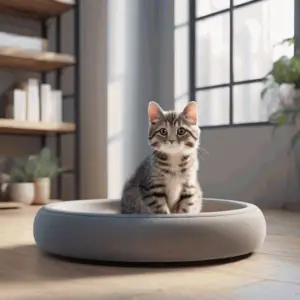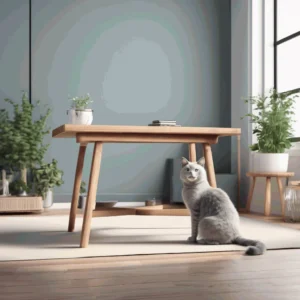You’ve just installed a brand new cat door so Mittens can come and go as she pleases. But there’s a problem – she has no idea what it’s for. Don’t worry, with some patience and the right techniques, you can train your cat to use her new door in no time. In this article, we’ll walk through the step-by-step process of teaching Mittens how to use her cat door. You’ll learn how to encourage her to approach and investigate the door through positive reinforcement. We’ll also cover troubleshooting for scaredy cats and those that might need a little more coaxing. With the tips outlined here, Mittens will be zipping in and out her new door independently in just a few days. Let’s get started!
The Benefits of Training Your Cat to Use a Cat Door
Training your cat to apply a cat door has many advantages. For starters, it gives your cat greater independence to return and move as they please.
Freedom of Movement
With a cat door, your cat can cross inside and outside on every occasion they want for some fresh air, to exercise, or to do their enterprise. This freedom of motion can help reduce behavioral troubles like scratching at doorways or windows to be let loose.
Reduced Hassle
Not having to open constantly and close doorways or manually let your cat inside and out makes lifestyles extra convenient. No greater rushing to the door when your cat is meowing to come inside or go outside. A cat door eliminates that trouble and offers you extra flexibility for your schedule.
Security
Contrary to what a few may think, a well-designed cat door does now not compromise home protection. Modern cat doors have locking mechanisms that simplest permit your cat’s customized collar or microchip to open the door. This prevents intruders from gaining admission at the same time as still allowing your cat to freely come and pass.
Independence
For many cats, the use of a cat door helps satisfy their herbal instinct to seek or patrol their territory. Giving a cat this independence and management over their surroundings can cause a generally happier and better-adjusted pet. Of path, you may still want to oversee your cat’s out-of-door pastime and make certain they may be saved up to date on vaccinations and flea/tick prevention.
Training a cat to use a cat door may additionally make an effort and patience, however, the rewards of extra freedom, fewer problems, and a happier cat are nicely worth the funding. Start slow with the aid of propping open the cat door and giving your cat treats after they go through. Once they’re going through with self-belief, you can eliminate the prop and revel in all of the benefits a cat door presents for you and your pussycat buddy.
Step-by-Step Guide to Train a Cat to Use a Cat Door
Choose a cat door and install it
Pick a cat door that is the appropriate size for your cat and install it in an area of your home that your cat frequently uses, such as near their food bowls or litter box. For the first few days, the prop opens the flap so your cat can get used to walking freely.
Feed your cat on one side of the door
Place your cat’s food bowl on one side of the cat door to encourage them to walk through it. At first, prop open the flap while they are eating. After a couple of meals, close the flap while they eat so they have to push through it to get to their food. This helps them associate the cat door with rewards.
Supervise and reward
Spend time with your cat while they explore the cat door. Gently guide them through the opening and give them praise, treats, and play to help them make positive associations. Never force your cat through the door, as this can frighten them and damage your trust. With patience and positive reinforcement, your cat will get more comfortable using the door on their own.
Once they’re using it freely, close the flap
After your cat has been walking through the open cat door freely for a week or so to access their food, play, or treats, you can close the flap for short periods while supervising them. Have some treats, toys, or playtime ready on the other side of the door to entice them to push through. Gradually increase the time with the flap closed. If at any time your cat seems hesitant or upset, open the flap again for a while and continue reinforcing with rewards before trying again.
With consistency, patience, and positive experiences, your cat will master the cat door. Before you know it, they’ll be using it on their own to come and go as they please! Make sure you continue to supervise them at first, especially if there are any potential dangers outside. With time and consistency, your cat door training will be a success.
Tips for Making the Training Process Easier on Your Cat
Start Training Early
It’s nice to begin training your cat to apply a cat door once they’re nevertheless a kitten. Kittens are certainly curious and willing to explore new matters. An older cat that’s never used a cat door earlier can be extra hesitant to attempt it out. Begin the education as soon as you put in the new cat door so your cat can get conversant in it properly away.

Keep the Flap Open at the First
Don’t expect your cat to immediately use the cat door with the flap down. First, secure the flap in an open position so your cat can freely walk through without any restrictions. This will allow them to get used to going in and out of the opening voluntarily. Only lower the flap once your cat seems fully comfortable passing through.
Use Treats and Praise as Positive Reinforcement
Giving your cat treats, pets, and rewards every time they use the cat door will assist them shape high-quality institutions with it. Place some treats just outdoor the cat door to entice your cat to go through, then reward and praise them enthusiastically once they do. Repeat this in some instances in keeping with the day until they start the usage of the door voluntarily.

Never Force Your Cat Through
Forcing or scaring your cat to go through the cat door may seriously damage their trust and make them afraid to use it. Always let your cat explore the cat door in their own time. Remain patient through the process, even if it takes several days or weeks. Forcing the issue will likely backfire and make training take longer.
With time and positive reinforcement, your cat should become quite comfortable using their new cat door. Stay consistent with treats and praise, keep the flap open at first, start training early, and never force them. If done right, your cat will soon have the freedom to come and go as they please!
Common Mistakes to Avoid When Training a Cat to Use a Cat Door
One of the most important errors human beings make is forcing a cat to apply the door before they’re ready. Cats are impartial creatures and don’t like being instructed on what to do. Forcing them will likely backfire and cause them to avoid the door altogether. Instead, introduce the door gradually and permit your cat to discover it on their terms.

Another unusual blunder isn’t always properly securing the door flap. If the flap swings around wildly or makes loud noises, it will startle your cat. Secure the flap so it has constrained motion and doesn’t make excess noise. You want your cat to look at the door as a safe passageway, no longer something horrifying.
Don’t punish or yell at your cat for no longer the use of the door properly. Negative reinforcement will no longer paint and could harm your bond of consideration. Remain patient and retain to undoubtedly inspire your cat with treats, play, and praise for any interest they show inside the door.
Leaving the cat door open all the time.
While it’s important to give your cat ample time to get used to the door, leaving it open constantly allows other animals easy access to food, and shelter, and can be unsafe. Only prop open the door during initial training and when you’re home to supervise. Once your cat is using it on their own, keep it closed when you’re not home or overnight.
Another common mistake is assuming a cat will figure it out on their own without guidance. Take an active role in the training process by leading your cat through the open door from inside and outside several times a day. Give a treat for their cooperation and praise them enthusiastically. Place treats outside the door to encourage exiting and inside for entering. With regular practice, your cat will soon associate the door with rewards and learn how to use it on their own.
With staying power, tremendous reinforcement, and averting those not-unusual mistakes, your cat will master the cat door very quickly. Consistency is prime, so stick with the education and avoid giving in to frustration. Your cat will get there when they’re geared up!
Conclusion
Bringing It All Together
You’ve come to an extended manner in training your cat to apply the cat door. By now, your cat ought to be getting into and out freely and sense cushty doing so. Be sure to continue offering effective reinforcement with treats and rewards each time it makes use of the door. If your cat continues to hesitate at instances or now not using it always, don’t get annoyed. Some cats take longer than others, so stay affected person and continue the education.
With regular use and practice over the next few weeks, your cat will get into the routine of using the cat door instinctively. Once you notice your cat is using it regularly without issue and seems fully comfortable doing so, you can stop providing treats each time. At this point, your cat has mastered this new skill and the training process is complete!
Possible Challenges
However, there are a couple of potential challenges to be aware of. Your cat may get spooked at some point by a noise outside or have a bad experience, causing it to regress in its training. Should this happen, go back to providing lots of positive reinforcement and treats to help build its confidence again. It’s also possible that another pet in the home or neighborhood may cause your cat to be hesitant to use the door. You may need to temporarily lock the cat door when the other animal is around until your cat is comfortable again.
With time and consistency, any challenges that come up can be overcome. The most important things are not giving up, providing a safe environment, and continuing to positively reinforce your cat for mastering this important skill. Before you know it, using the cat door will become second nature and give your cat the freedom and independence to come and go as it pleases!
FAQs
[sp_easyaccordion id=”369″]



